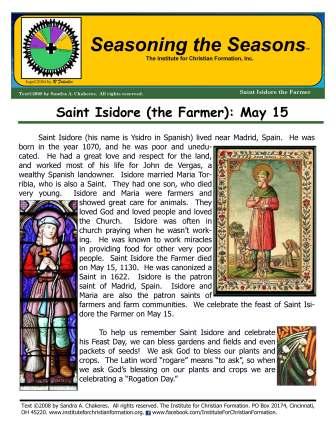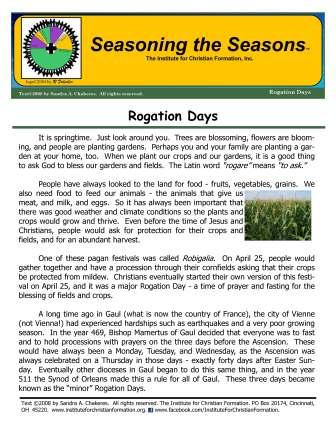The Institute for Christian Formation
Follow us on Facebook to keep up to date with our news and newest resources!
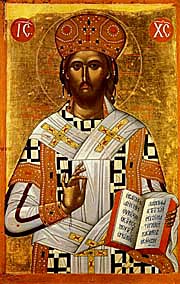
Saint Isidore (the Farmer)
Feast Day (optional memorial) : May 15 (USA)
Saint Isidore the Farmer, ca. 1750. Oil on canvas, 31 1/8 x 24 1/4in. (79.1 x 61.6cm). Brooklyn Museum, Museum Expedition 1941, Frank L. Babbott Fund, 41.1275.189
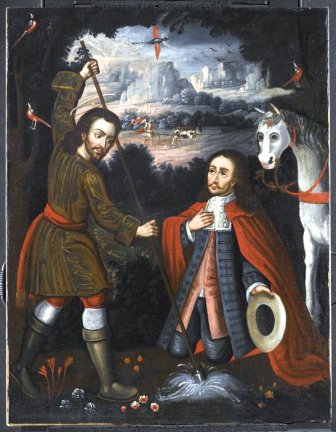
Saint Isidore (his name is “Ysidro” in Spanish) lived near Madrid, Spain. He was born in the year 1070, and he was poor and uneducated. He had a great love and respect for the land, and worked most of his life for John de Vergas, a wealthy Spanish landowner. Isidore married Maria Torribia, who is also a Saint. They had one son, who died very young. Isidore and Maria were farmers and showed great tenderness towards animals. They loved God and loved people and loved the Church. Isidore was often in church praying when he wasn’t working. He was known to work miracles in providing food for other very poor people. Saint Isidore the Farmer died on May 15, 1130. He was canonized a Saint in 1622. Isidore is the patron saint of Madrid, Spain. Isidore and Maria are also the patron saints of farmers and farm communities. The Catholic Rural Life Conference in the United
States asked that in the USA we celebrate Saint Isidore’s feast day in mid-May, as that is a time of planting. So each year in the dioceses of the United States, May 15 is designated as the optional memorial of Saint Isidore. View the reflection below, from The Apostleship of Prayer, about Saint Isidore.
You can also learn more about Saints Isidore and Maria from the National Catholic Rural Life Conference (NCRLC). They even have a novena to Saint Isidore.
You can also celebrate Saint Isidore the Farmer’s feast day in your own home and neighborhood. Do you have a garden? You could plant some seeds and have a blessing of your garden. Catholic Household Blessings and Prayers (©United States Conference of Catholic Bishops) has an order of service for Rogation Days: Blessings of Fields and Gardens which you could use. Or if you do not have this book, you could simply say a prayer asking God to bless your garden and help your flowers and produce grow and be fruitful. And don’t forget to ask Saints Isidore and Maria to pray for your intentions, as well. You could even have your own Rogation Day procession! (See below for an explanation of rogation days.) Walk around your garden or yard and stop at various points along the way, asking for God’s blessing on the various trees and plants. If you don’t have a garden, this would be a good time to plant a few seeds in a pot to keep in your home by a window. Water and tend it carefully, and watch it grow, asking God to bless your plant.
Rogation Days
In the spring of the year in the northern hemisphere trees are blossoming, flowers are blooming, and people are planting gardens. When we plant our crops and our gardens, it is a good thing to ask God to bless our gardens and fields. The Latin word “rogare” means “to ask.”
People have always looked to the land for food - fruits, vegetables, grains. We also need food to feed

our animals - the animals that give us meat, and milk, and eggs. So it has always been important that there would be good weather and climate conditions so the plants and crops would grow and thrive. Even before the time of Jesus and Christians, people would ask for protection for their crops and fields, and for an abundant harvest. One of these pre-Christian festivals was called “Robigalia”. On April 25, people would gather together and have a procession through their cornfields asking that their crops be protected from mildew. Christians eventually started their own version of this festival on April 25, and it was a major Rogation Day - a time of prayer and fasting for the blessing of fields and crops.
Centuries ago in Gaul (what is now the country of France), the city of Vienne (not Vienna!) had experienced hardships such as earthquakes and a very poor growing season. In the year 469, Bishop Mamertus of Gaul decided that everyone was to fast and to hold processions with prayers on the three days before the celebration of the Ascension. These would have always been a Monday, Tuesday, and Wednesday, as the Ascension was always celebrated on a Thursday in those days - exactly forty days after Easter Sunday. Eventually other dioceses in Gaul began to do this same thing, and in the year 511 the Synod of Orleans made this a rule for all of Gaul. These three days became known as the “minor” Rogation Days.
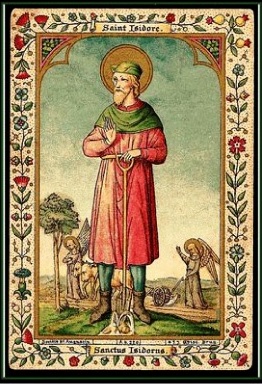
Pope Leo III, who was pope from 795 to 816, began celebrating these “rogation day” processions in Rome, but he did not have the people fast. These days fell during the Easter Season, and it was actually forbidden to fast during Easter!
Rogation Days began to be observed in various places with various traditions. In some places one of these traditions was called “Beating the Bounds.” This tradition seemed to bring together and Christianize two older pre-Christian Roman festivals. One of these was called “Terminalia” (Terminus was the Roman pagan god of boundaries).The other was called “Ambarvalia”, when people would parade around their fields and beat the ground with sticks to get rid of the winter!
When these customs were combined and taken over by the Christians, the Christians would process around the boundaries of their parish. They would stop along the way at major focal points and hit the ground (or sometimes even tap a young parishioner) with sticks to help everyone remember their parish boundaries as they processed and prayed. If any bad feelings existed over the boundaries, this was also a time of reconciliation and healing and mending relationships. In some areas of Britain, Rogation Days were called “Gang Days.” The Anglo Saxon word “gang” meant “to go.” Again, the people would go around the parish praying for blessing of the crops as they walked.
The year 1969 saw the reform of our Roman Catholic Liturgical Calendar. On rogation days, the Church still publicly thanks God and prays for the needs and work of humans, and for the fruitfulness of the earth. However, the dates for rogation days and exactly how they would be celebrated was left up to the conferences of bishops.
April 25 is the Feast of Saint Mark, and was also formerly the major Rogation Day. The Blessing of Fields and Flocks from the official Book of Blessings (©United States Conference of Catholic Bishops) may be celebrated on this day or at another appropriate time in rural areas. The three days before Ascension (when Ascension was celebrated on a Thursday) were the minor Rogation Days. The Blessing of Seeds at Planting Time, also from Book of Blessings may be celebrated on these days in rural areas, or another day may be chosen. In many areas in the United States, this “other day” is May 15, the feast (optional memorial in the United States) of Saint Isidore (the Farmer). Remember that the Latin word “rogare” means “to ask.” When we celebrate Rogation Days, we are asking for God’s blessing.
Click on the image above to download our ICF handout on Saint Isidore.
Click on the image above to download our ICF handout on Saint Isidore and Rogation Days.
On the feast of Saint Isidore, pray in a special way for all farmers and those whose livelihood is based in rural areas. Learn more about the issues facing these workers. You can learn more from the National Catholic Rural Life Conference (NCRLC), and the United States Conference of Catholic Bishops (USCCB).
